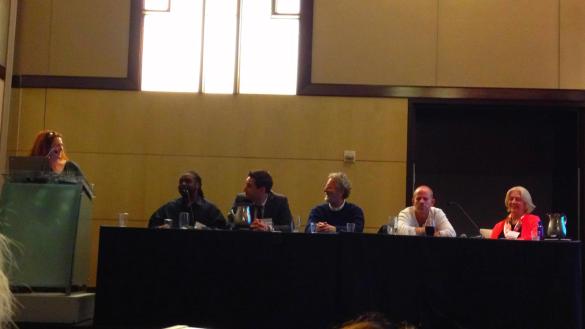
Scene from Inglorious Basterds, Quentin Tarantino
with…
Karl Iglesias, Instructor, UCLA Writer’s Program
Steve Faber, Screenwriter (Wedding Crashers)
William Martell, Screenwriter (HBO, Showtime, USA Net, CineMax Originals), First Strike Productions
William Massa, Screenwriter (Silver Pictures, Dark Castle, Warner Brothers, Sony, Maverick, MGM, USA and Mandalay)
Anthony Grieco, Screenwriter, Story Specialist at The Writers Store
How important is dialogue in script?
Anthony: Dialogue can be wonderful and funny, when you go through a script… and yet you’ll have scenes where actors say nothing in the scene. Unless you’re surrounded by a roomful of talented actors… whenever you can take words out of an actor’s mouth, do it. If you can show the character’s behavior instead, do it. Show, don’t tell. Most productions have no access to A-list actors. Have your character react a certain way, by default.
Steve: No one speaks in real-life like they do in dialogue. Set-up, punch. Set-up, punch. Except for historical biography, there is no “real life dialogue”. There is a “hyper” or “meta” dialogue.
Karl: Real-life dialogue.
How do you make hyper dialogue and make it sound natural?
Steve: Depending on the genre, e.g. with horror, characters will scream.
Bill Massa: The only thing when you’re reading is dialogue (script) telling the story therefore concept, story, characters, can be more important on a macro-level but dialogue jumps out at the reader.
Karl: Least important – this doesn’t drive the story. What’s important is that readers read dialogue – trying to grasp the story through dialogue (vertically), and therefore, it’s not a conversation. It’s action. In a scene, there are only 2 ways a character can get something: either physically or verbally. Real dialogue is action.
Anthony: Attitude towards the world. Flesh out character. Propels them to say things that are true to them.
How do you give dialogue distinctive character voices?
Bill: Attitude of broad strokes: create conflict.
Steve: Pick an actor at a given point in their career, and write in their voice. I pitched Wedding Crashers to 9 studios before I realized that Owen was not talking as fast as Vince… so I had to rewrite all of his lines.
Karl: Contrast in scenes (emotional tempo: way characters feel in a scene). Favorite expressions, pet words. In Lost: Jack Sawyer’s character nicknames every character.
Steve: Moral lines in the sand. One character offending another character. That can manifest in great dialogue.
Bill: Rhythmn. Cadence. The Coen brothers are masters at this.
Anthony: Look at archetypes. Choose attitudes. Writer as an actor in the room. Drop into a place in your stomach that emotionally resonates with how a person is feeling in the scene. With each draft, find out all the characters’ ticks. Not all is lost if the components are not all working in the first draft.
Karl: Every line has to have a reason. Not exposition (interrogation scene). Use dialogue to get something from someone.
Bill M: In the Matrix, big chunks of the movie is exposition. Because we’re so intrigued, we don’t feel that this is just dumped on us. Very strong visuals. Exposition on the run. (Elements of danger).
How do you make dialogue sound natural, again?
Karl: Stilted dialogue is something that is grammatically correct, with full sentences, like an encyclopedia. Use contractions. If you want to say, “I want to go to the theatre tomorrow”, the trick is to contract it “I’m…” “I’ll”…. Have fragmented sentences. Cut words out.
Anthony: Go through your script, and take out “well” and ‘look” from all the first words.
Karl: It’s about trimming to the bone.
Steve: I like characters who F*** up what they’re saying and then correct themselves. It’s a trick, it’s also part of human nature.
Anthony: Have your character spit a question out in their mind, and then state the answer before asking the question out loud.
Bill M: In real life, people interject. Running paragraphs don’t work in Casablanca – it’s all one line.
Karl: Finger rule: it should be no thicker than a finger horizontally. Write tightly. (Subtext) Imply vs stating on the nose. E.g. first date questions – Quentin Tarantino, Ron Bass write good dialogue.
